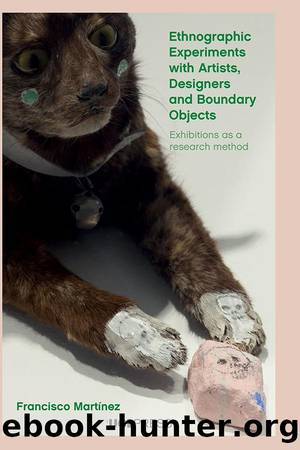Ethnographic Experiments with Artists, Designers and Boundary Objects by Francisco Martínez

Author:Francisco Martínez [Martínez, Francisco]
Language: eng
Format: epub
Tags: Social Science, Anthropology, Cultural & Social
ISBN: 9781800081086
Google: o5RLEAAAQBAJ
Publisher: UCL Press
Published: 2021-11-01T04:26:26+00:00
Objectography
One has to be careful with the selection of objects. Take only those that will be used and cared about. A substantial connection to objects, or even just their company, might make people anxious. Objects do not easily accept being lost, forgotten or ignored; they wait for their moment to strike back. You cannot mention âRosebudâ and then forget about the sled, or pretend that love letters at the bottom of a drawer will always be silent.
Things are not just present; they are made so by diverse human perceptions. Through our embodied engagements with them and through situated notions of value, worth, functionality and validity, we can even identify agency in objects. As a cultural phenomenon, and as with texts and images, things can be taken as evidence, helping us to gain insight into the societies that produce them, as tangible remains that continually convey meanings. In this light we can make the following arguments:
1) Inanimate things give symbolic meaning to human activity, as they have the ability to signify something, mediate human experience and carry out social functions
2) Things mirror and condense social phenomena, as a day-to-day metabolism acted upon by people
3) Since things convey experience and express meaning, they can be taken as evidence that allows us to reconstruct lifeways, imaginaries or particular human (in)activities.
People surround themselves with stuff possessing practical, aesthetic, political or affective value; they collect it, use it and abandon it, imbue it with symbols and imaginings, create comfort with it and entertain with it. It is therefore relevant to investigate how things become loaded with particular significance, and the way they can participate in social settings. Pushing beyond the (vague) concepts of materiality and material agency, Pierre Lemonnier insisted on starting our research by acknowledging the very physicality of objects and the ways in which they are manufactured and used ordinarily. Specifically, he focused on mundane objects in Papua New Guinea (such as eel traps, garden fences and drums). Such artefacts:
would not find their way into museum cases and ⦠are uninteresting to most anthropologists, sociologists and historians, but nonetheless lie at the heart of the systems of thought and practices of their makers and users (2012, 13).10
Objects are cultural artefacts made (and often owned) by people. If we remove the subject, however, we risk depoliticising objects and ignoring power relations and the work of affects. As pointed out by Daniel Miller, objects are able to perform social tasks precisely because we are often unaware of them; they set our scene without consciously being challenged by us. He refers to this phenomenon as âthe humility of thingsâ (1987; 2005), noting that the less aware we are of the company of things, and their participation in our actions, the more powerfully they influence what we do and see. Objects may even have an infrastructuring capacity for bringing together, relating to, coordinating, organising and making public (Niewöhner 2015). They generate particular modes of being, making peopleâs behaviour and objects appear as one.
For instance, Tomás Errázuriz (2019)
Download
This site does not store any files on its server. We only index and link to content provided by other sites. Please contact the content providers to delete copyright contents if any and email us, we'll remove relevant links or contents immediately.
Technical Art History by Jehane Ragai(456)
Art, Science, and the Natural World in the Ancient Mediterranean, 300 BC to AD 100 by JOSHUA J. THOMAS(410)
Graphic Culture by Lerner Jillian;(397)
The Slavic Myths by Noah Charney(370)
Pollak's Arm by Hans von Trotha(340)
Simply Artificial Intelligence by Dorling Kindersley(338)
Treasuring the Gaze by Hanneke Grootenboer(337)
Sketchbook Confidential: Secrets from the private sketches of over 40 master artists by Editors of North Light Books(337)
The Art of Portrait Drawing by Cuong i(331)
Drawing for the Soul by Zoë Ingram(328)
Drawing Landscapes by Barrington Barber(320)
Mountain Manâs Field Guide to Grammar by Gary Spina(312)
The Art of Painting Sea Life in Watercolor by Maury Aaseng Hailey E. Herrera Louise De Masi and Ronald Pratt(310)
Portrait of a Woman by Bridget Quinn(300)
Anatomy for the Artist by Jennifer Crouch(293)
A text-book of the history of painting by Van Dyke John Charles 1856-1932(288)
Preparing Dinosaurs by Wylie Caitlin Donahue;(281)
Botanical Illustration by Valerie Price(280)
Egyptian art by Jean Capart(277)
